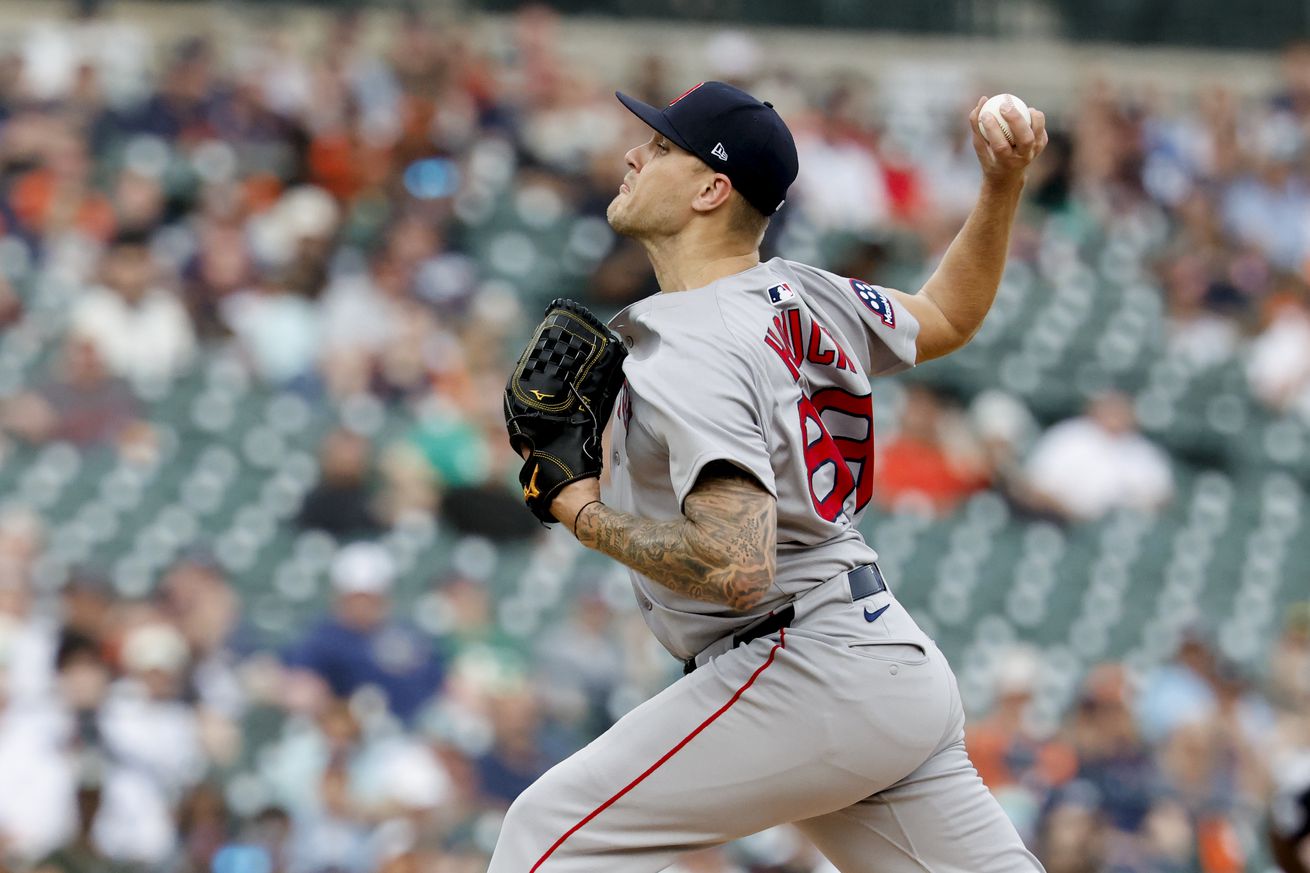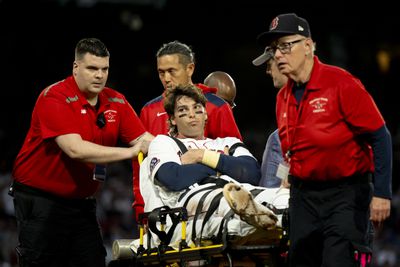
Time heals all wounds? Sending good thoughts to Tanner Houck.
The news about Tanner Houck needing Tommy John surgery was bad news for the Red Sox, for sure. But at least it pinpoints what’s gone wrong with Houck’s performance since the All-Star break last year, and offers a solution. Maybe he can come back fortified and ready for battle again.
But it hit me a little differently, this news, this time. I’m in the middle of recovering myself from a grueling physical setback. I have two herniated discs, and gang, it sucks.
Every time I do my physical therapy exercises, I think about any player who’s ever been on the IL long-term. Max Scherzer, Mitch Haniger, and others have had an in-season herniated disc, and I don’t know how the hell they did it. Miguel Cabrera, like me, had two. I now feel a little closer to each of our injured Red Sox players and what they’re also going through.
I’m not trying to compare myself to professional athletes. That would be hysterically funny, even though I’d have considered myself an active person before this happened. No, I’m thinking of this from a broader, more human angle. We’re all simply trying to get our normal lives back. For Tanner Houck, that’s throwing fastballs at 98 MPH. For me, that’s walking my dog again, sitting down in a chair without pain, driving a car, carrying groceries.
And of course, everyone who’s recovering from something is on their own big, beautiful, individual journey. But I see these injured players better now.
Every morning as I lay on the ground to do my prescribed Side-Lying Hip Abduction exercise, and feel the pain as I rotate my toes down and raise my leg, I have to remind myself not to tense my shoulders, or ball my fists, or arch my back. It’s really hard not to do those things when every fiber of your body is invested in getting the job done, and when your whole body is shaking with fatigue and concentration; all the parts want to chip in and help you get there. But that’s not helpful. The injured parts have to learn to do the work. I have to position my back against the wall to even know if I’m in the correct position because I can’t tell without a guardrail. I need the support of the wall so I can place my back properly, then I move my heel up and down along it so I don’t wobble out in front. Without the wall, my leg moves forward and back, as well as up and down, when it should only move in one plane like a traffic gate.
I do this, and I think of Triston Casas.

Photo by Maddie Malhotra/Boston Red Sox/Getty Images
This is exactly what it feels like on the inside.
With a big injury, your world gets smaller. For me, I have trouble sitting, so going even ten minutes to the doctor’s office has meant white-knuckling it since May. I can’t drive of course, so I can ask someone for a ride or pay for an Uber. I know many of the drivers in this area, some of them fairly well now.
“Hey, good to see you again. You going to the same place as last time?”
Yes, because I pretty much only go to the pharmacy, the doctor, or the other doctor.
I had to be taught to walk again. To stand, even. For godsakes, even a baby learns to do those things on their own!
This is what I now know about professional athletes who land on the IL with a significant injury.
I know that normal life feels very far away, even when you can see progress. For a while, I could only shuffle halfway down the alley behind our house. That’s maybe 60 feet, and it was a push. I gradually stretched it to one block, then two. Now I’m up to three blocks square. I have to keep my house in the center of this square so that I’m never too far from home if I run into trouble. Meanwhile, I’m constantly reminding myself about how to move my legs, distribute my weight, swing my arms, and more.
I know that there are good days—and there are bad days. I’m walking better now, but I still lurch around, especially on a bad day. One physical therapist told me I moved like a robot. Another said I had to learn to walk like a human again. They said it kindly, and their only goal is to help me get better. It was probably the meds that made the comments cut to the quick. That’s not me, I told myself. I move like a human; I am a human. Even if I don’t feel like myself.
I know that these long-term injuries can take away your sense of self and make you do embarrassing things. My meds make me loopy and emotional. I reach for words and trains of thought that completely escape me. I know for a fact I’ve said some really weird shit to people. I’ve had dreams I can’t bear to repeat. I had to point my bare ass toward the ceiling to receive an epidural steroid shot while a nurse squatted on the ground by my head and talked to me about my dog so that I’d stop crying. Just a couple days ago, I started weeping at a work gathering because I’d accidentally overdone it on only my third day back in person (and I only go for four hours at a stretch!). I was pushed to the brink of my capabilities, and that’s how my body informs me of that these days. Thanks a lot! There have been other side effects of my meds that were painful and embarrassing in ways that I just don’t want to get into here.
I know that there are important things you miss out on. At a minimum for Houck, that’s going to be supporting his teammates—and maybe more, if the Sox secure a playoff berth. Today, I was supposed to get on a plane to go on a family vacation that’s been planned for over a year. Except that I can’t sit long enough to get on a plane. Everyone went without me. Everyone went without me to Ross Lake, to multiple farewell parties at work, to all three games of the Red Sox lone visit to Seattle in 2025. I missed Irish Heritage Night at T-Mobile Park and two important art exhibitions. I have repeatedly felt like a little kid who got mono or something over the summer and can only look out the window while all the other kids play.
These are the things I’m talking about, the types of things that I have in common with injured athletes. Casas said he can’t stand to watch baseball when he’s injured and I totally get that, although baseball games have been a big comfort to me during this time. Thank god for them. And Gilmore Girls. Because sometimes the pain is so bad you can’t think—no reading, no working, and certainly no witty conversation. The meds have made that a distant memory, even when the pain hasn’t.
I have a whole new understanding of what it means to battle back. And it is a battle.

Photo by Jaiden Tripi/Getty Images
Those are just some of the physically grueling parts. There’s an emotional side too. There are wonderful people who have sent some kindness my way, whether by sending an email, text, or just good vibes. I’ve gotten very kind emails from readers (thank you, guys!). My girlfriend has made many meals for me, checked on me while I sleep, and more. Neighbors have given me their number in case I need a ride. My boss has been wonderful. A couple of unexpected gifts have arrived and they were everything. My kindergarten teacher and her husband write regularly, and my high school English teacher said he wished we were neighbors so that he could help take care of me! [Sob!] Those are people who have made me feel seen, and it means a lot. Then there are people I talk with all the time who have ignored this whole thing. Or others who have said, “Oh, is that still going on?”
Yeah, it’s still going on, and it might take months to not feel tingling in my leg, numbness in my foot, or blasts of pain in my glute when I move the wrong way.
I bet athletes deal with that too. Once they go on the IL for a significant period, we tend to forget about them for a while. You know we do. It’s sad, but maybe it’s human nature. Out of sight, out of mind. And once they’re back in the public eye, we think they’re fine. But they’re still on their journey. This big, beautiful, individual journey, goddammit.
My therapist—and I know this is something else I have in common with the athletes because there’s no way they aren’t seeing a sports psychologist with all this going on—said that Americans can’t stand long-term “invisible” injuries. Culturally, we don’t know how to deal with them, or talk about them. It’s almost easier, for others, to have a seriously debilitating diagnosis—to be assigned to a “stage,” to be in the hospital. A stage has specific parameters. A hospital stay has an end date. If it’s something you can see, that’s even easier to wrap your mind around: a bandage comes off, eventually. Those are things we know how to handle. But approaching and understanding the everyday grind of someone trying to get better, being on a long-term, physical journey—that’s not really in our wheelhouse.
If I had a really good story for why I herniated two discs, that might make it a little better. Everybody loves a good story, and they always ask me about mine. How’d it happen? they say.
I chased a purse snatcher through the Trader Joe’s parking lot after he mugged an elderly woman, and I threw out my back when I ran him to the ground. That’s how.
How about, I wrenched my back when I grabbed back a bike that some bully stole from a smaller child.
No. It doesn’t always happen because of some noble, heroic effort. All those athletes who don’t have a “good-enough” story must be reminded of that. Casas was simply running to first base. Sometimes a foot lands wrong on the base. Ricky Romero, Kevin Pillar, and Sammy Sosa all suffered injuries just by sneezing. I was reminded of my own feeble story when we acquired Dustin May at the trade deadline; in 2024, he suffered an esophageal tear from eating a piece of lettuce.
Here’s mine: my girlfriend and I drove a couple of hours to visit some friends and binge-watch the Eurovision Song Contest all weekend. That’s it. Apparently, I sat on my ass too long! Even though I do this every year, this time it was just too much. Sigh. And on top of that, the best song didn’t even win (alas, none of my favorites did). A lost weekend, indeed.
So what is the lesson here? I’m sad to see Tanner Houck go down with this injury. I know—in a way I didn’t before—that his recovery will be long and arduous. Now I’ll be thinking of him as well when I’m in the middle of my most difficult PT exercises. But it’s also some kind of relief to have a diagnosis, and to know what you’re working toward. Full recovery is what we’re all working toward of course, but now his path becomes clearer. It’s hard to be on the path, but I see you, fellow travelers. I see you. Get well soon.